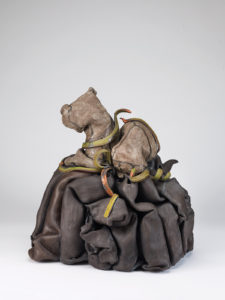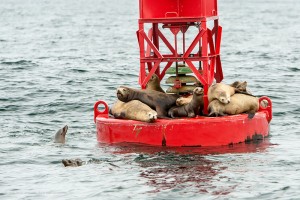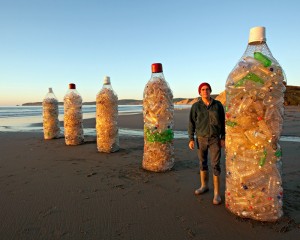The 16 giant plastic sea creature sculptures now on display at the Marine Mammal Center in the Marin Headlands arose from an unlikely inspiration: the death of Oregon artist Angela Pozzi’s husband more than a decade ago.
“I went to the ocean to look for healing, but I found that the ocean needed healing before it could heal me,” says Pozzi in her speech at the ribbon cutting of her new exhibit, Washed Ashore, which opened on June 25, 2011.
Pozzi esplains that when her husband began having mild seizures in 1994, a brain tumor was misdiagnosed as panic attacks. A court case against Kaiser Permanente eventually led to a $4.5 million settlement awarded to Pozzi.
Pozzi decided to use the money from the lawsuit to fund a new effort to get the large amounts of plastic washed onto Oregon beaches cleaned up. She organized 100 volunteers to collect more than 7,000 pounds of washed up trash over 20 miles of beach in Oregon. They cleaned and sorted the plastic by color to eventually construct the 16 giant sea creatures now on display at the Marine Mammal Center.
“The whole idea of this project is to pull people into what’s going on in the ocean, so I try to do things that people can’t resist taking their picture in front of.”
Some of the plastic washed onto these Oregon beaches comes from the North Pacific Gyre, an area of swirling currents where an estimated 11 million tons of plastic floats between Asia and North America. Plastic trapped in the gyre eventually breaks into smaller and smaller pieces. At each level, some of that plastic looks like food to some passing sea creature or bird.
Some of the trash Pozzi found and included in the sculptures can even be roughly dated: “Henry the Fish” has an orange plastic bottle popular in the 1970s, and Pozzi’s musical starfish has a large collection of bottles emblazoned with the 2008 Beijing Winter Olympics logo.
The sculptures themselves serve a practical purpose, as a visible destination for trash collected off the beach. “Picking the trash up off the beach is a double-edged sword: You pick it up and put it into landfill, so no one sees it. We try to use 100 percent of the trash we collect,” Pozzi reports during a tour of her sculptures at the Marine Mammal Center.
Pozzi argues that ocean plastic is more dangerous even than oil spills. Unlike plastic, oil eventually breaks down and becomes digestible by various organisms. Also, when an oil spill happens in a particular place, someone is responsible for it and its ensuing clean-up. Plastic, on the other hand, flows from many sources into five major gyres around the globe, far from shore.
In 2007, when a sperm whale washed up on a California beach, scientists found enough plastic in its stomach to fill three large refrigerators. Marine Mammal Center Executive Director Jeff Boehm says he was motivated to show Pozzi’s work because ten percent of the center’s animal patients arrive entangled in plastic.
When asked what one thing she’d most like her viewers to take from her exhibit, Pozzi says, “Stop and think about your plastic use, it is possible to turn things around but we have to think about our issues in a positive way to get out of this mess we’re in.”
The Washed Ashore exhibit will be at the Marine Mammal Center through October 15. Learn more at marinemammalcenterart.org.
Pozzi is also working on a feature-length documentary about this project, due out at the end of the summer.

.jpg)



